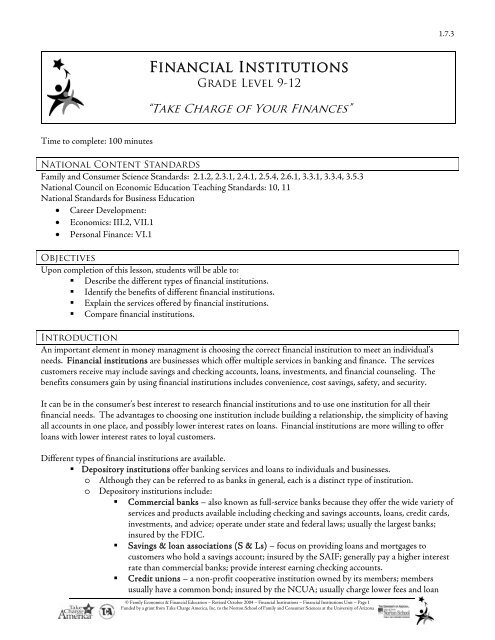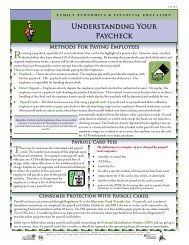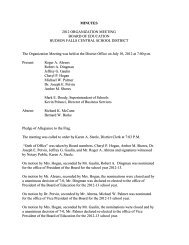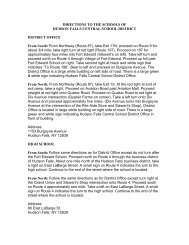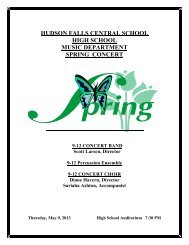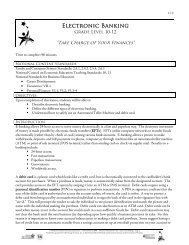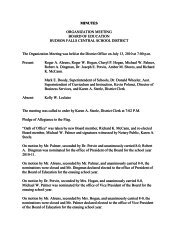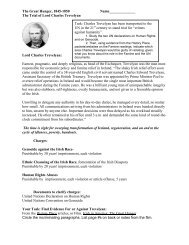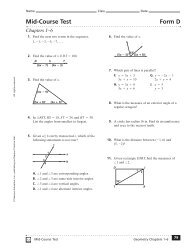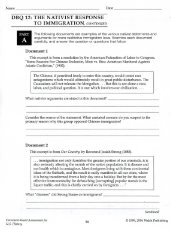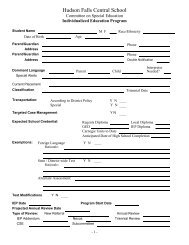Financial Institutions Lesson Plan
Financial Institutions Lesson Plan
Financial Institutions Lesson Plan
Create successful ePaper yourself
Turn your PDF publications into a flip-book with our unique Google optimized e-Paper software.
1.7.3<br />
<strong>Financial</strong> <strong>Institutions</strong><br />
Grade Level 9-12<br />
“Take Charge of Your Finances”<br />
Time to complete: 100 minutes<br />
National Content Standards<br />
Family and Consumer Science Standards: 2.1.2, 2.3.1, 2.4.1, 2.5.4, 2.6.1, 3.3.1, 3.3.4, 3.5.3<br />
National Council on Economic Education Teaching Standards: 10, 11<br />
National Standards for Business Education<br />
• Career Development:<br />
• Economics: III.2, VII.1<br />
• Personal Finance: VI.1<br />
Objectives<br />
Upon completion of this lesson, students will be able to:<br />
• Describe the different types of financial institutions.<br />
• Identify the benefits of different financial institutions.<br />
• Explain the services offered by financial institutions.<br />
• Compare financial institutions.<br />
Introduction<br />
An important element in money managment is choosing the correct financial institution to meet an individual’s<br />
needs. <strong>Financial</strong> institutions are businesses which offer multiple services in banking and finance. The services<br />
customers receive may include savings and checking accounts, loans, investments, and financial counseling. The<br />
benefits consumers gain by using financial institutions includes convenience, cost savings, safety, and security.<br />
It can be in the consumer’s best interest to research financial institutions and to use one institution for all their<br />
financial needs. The advantages to choosing one institution include building a relationship, the simplicity of having<br />
all accounts in one place, and possibly lower interest rates on loans. <strong>Financial</strong> institutions are more willing to offer<br />
loans with lower interest rates to loyal customers.<br />
Different types of financial institutions are available.<br />
• Depository institutions offer banking services and loans to individuals and businesses.<br />
o Although they can be referred to as banks in general, each is a distinct type of institution.<br />
o Depository institutions include:<br />
• Commercial banks – also known as full-service banks because they offer the wide variety of<br />
services and products available including checking and savings accounts, loans, credit cards,<br />
investments, and advice; operate under state and federal laws; usually the largest banks;<br />
insured by the FDIC.<br />
• Savings & loan associations (S & Ls) – focus on providing loans and mortgages to<br />
customers who hold a savings account; insured by the SAIF; generally pay a higher interest<br />
rate than commercial banks; provide interest earning checking accounts.<br />
• Credit unions – a non-profit cooperative institution owned by its members; members<br />
usually have a common bond; insured by the NCUA; usually charge lower fees and loan<br />
© Family Economics & <strong>Financial</strong> Education – Revised October 2004 – <strong>Financial</strong> <strong>Institutions</strong> – <strong>Financial</strong> <strong>Institutions</strong> Unit – Page 1<br />
Funded by a grant from Take Charge America, Inc. to the Norton School of Family and Consumer Sciences at the University of Arizona
1.7.3<br />
rates and offer higher interest rates than commercial banks and S & Ls; many offer free<br />
financial counseling; accounts offered include share, share draft, and share certificate<br />
accounts.<br />
• Brokerage firms are licensed institutions which specialize in investing. They offer money management<br />
plans to buy and sell stocks, bonds, and other cash investment opportunities through cash management.<br />
Insurance for <strong>Financial</strong> <strong>Institutions</strong>:<br />
The Federal Deposit Insurance Corporation (FDIC) is a federal government agency which insures federally<br />
chartered commercial banks against loss. The Savings Association Insurance Fund (SAIF) provides insurance for<br />
savings & loan associations and is a branch of the FDIC. The National Credit Union Administration (NCUA)<br />
provides insurance protection for credit unions. Each depositor is insured up to $100,000. If the institution is<br />
insured, it will be posted in view for the customer to see. Customers should choose a FDIC, SAIF, or NCUA<br />
insured financial institution for protection against the risk of loss.<br />
Services of <strong>Financial</strong> <strong>Institutions</strong>:<br />
• Bond—Lending money to an organization as an investment.<br />
• Certificate of Deposit—An insured interest earning savings instrument with restricted access to the<br />
funds.<br />
• Checking Account—Paper checks or debit cards are used to withdraw money deposited into the<br />
account to pay for items. They may be non-interest bearing.<br />
• Credit Card—A card used to make a purchase now and must be repaid later.<br />
• <strong>Financial</strong> Counseling–Information and advice is given to customers to help them make decisions about<br />
financial issues.<br />
• Investment—A commitment of money to achieve long-term financial goals.<br />
• Loan—Borrowed money members apply for to be paid back at various interest rates.<br />
• Mortgage—A loan to purchase real estate.<br />
• Mutual Fund—Groups of stocks, bonds, and other investments managed by an investment firm.<br />
• Real Estate Investment—Purchase real estate as an investment to gain a profit.<br />
• Retirement <strong>Plan</strong> Account—<strong>Plan</strong>s to set aside money for retirement. Money is tax-deferred until<br />
withdrawn.<br />
• Safe-Deposit Box—A secured box in a bank to be used for valuable and important personal items.<br />
• Savings Account—Money is deposited into an account to earn interest.<br />
• Share Account—A savings account at a Credit Union.<br />
• Share Certificate Account—A certificate of deposit (CD) at a Credit Union.<br />
• Share Draft Account—A checking account at a Credit Union.<br />
• Stock—Ownership, represented by shares, in a corporation.<br />
In this lesson, the students learn about different types of financial institutions, the benefits of using them, and the<br />
services offered. Students learning will be reinforced when they complete an activity matching financial<br />
characteristics to financial institutions.<br />
*Note to teacher: Services are discussed more in-depth in other lessons. This is just a quick overview to introduce<br />
the services to the students.<br />
© Family Economics & <strong>Financial</strong> Education – Revised October 2004 – <strong>Financial</strong> <strong>Institutions</strong> – <strong>Financial</strong> <strong>Institutions</strong> Unit – Page 2<br />
Funded by a grant from Take Charge America, Inc. to the Norton School of Family and Consumer Sciences at the University of Arizona
1.7.3<br />
Body<br />
1. Students should read the <strong>Financial</strong> <strong>Institutions</strong> information sheet 1.7.3.F1 the night before as homework to<br />
be prepared for the activity.<br />
2. Ask the students how many currently use a financial institution such as a bank. Ask how they chose to use<br />
the financial institution they are currently using.<br />
3. Tell the students today’s discussion is on financial institutions, services, and benefits.<br />
4. Discuss the types of financial institutions, benefits, and services offered by using the <strong>Financial</strong> <strong>Institutions</strong><br />
PowerPoint presentation 1.7.3.G1.<br />
a. The <strong>Financial</strong> <strong>Institutions</strong> Review worksheet 1.7.3.A2 to accompany the <strong>Financial</strong> <strong>Institutions</strong><br />
PowerPoint presentation 1.7.3.G1 is available for students to complete during or after the<br />
presentation.<br />
b. OR – The <strong>Financial</strong> <strong>Institutions</strong> Review worksheet 1.7.3.A2 which accompanies the presentation<br />
may be used in conjunction with the <strong>Financial</strong> <strong>Institutions</strong> information sheet 1.7.3.F1. All<br />
questions may be answered by reading it. Students could fill out the worksheet according to the<br />
information sheet if they missed the PowerPoint presentation.<br />
c. OR – The <strong>Financial</strong> <strong>Institutions</strong> Review worksheet 1.7.3.A2 may be used as a quiz to ensure the<br />
students read the information sheet.<br />
5. After the PowerPoint presentation, proceed with the following activity.<br />
6. Class Activity –<br />
a. Directions:<br />
i. Divide the students into teams of three.<br />
ii. Each team begins with a $50.00 savings account and one set (four) of <strong>Financial</strong> <strong>Institutions</strong><br />
game cards 1.7.3.H1 stating commercial bank, savings and loan, credit union, and brokerage<br />
firm.<br />
iii. The teacher needs to have extra play money and one set (22) of <strong>Financial</strong> <strong>Institutions</strong><br />
statement cards.<br />
iv. The teacher begins the game by reading a statement card describing a financial service. The<br />
students determine as a team which financial institution offers the service and they hold up<br />
their card. Some statement cards list a service offered at more than one financial institution.<br />
If so, students should hold up the game cards for all financial institutions pertaining to the<br />
service listed on the statement card.<br />
v. If the teams are correct, they receive $5. If a statement card has multiple correct answers<br />
and the students hold up all of the correct game cards, they receive $5 for each answer.<br />
vi. If the students answer the question incorrectly, the team needs to give the teacher $10 from<br />
their savings account for each incorrect answer.<br />
vii. The group with the largest savings account wins.<br />
viii. During the activity, students may complete the Statements for <strong>Financial</strong> <strong>Institutions</strong><br />
worksheet 1.7.3.A1 indicating which service was available at what financial institution(s) to<br />
have a study guide –OR- it could be used as after the activity (see below).<br />
b. OR - For an individual activity, provide each student with a Statements for <strong>Financial</strong> <strong>Institutions</strong><br />
worksheet 1.7.3.A1. Read the statement cards out loud and have students check which institution<br />
is described by the statement card.<br />
7. OR - The Statements for <strong>Financial</strong> <strong>Institutions</strong> worksheet 1.7.3.A1 could be used as a final conclusion after<br />
the activity has been completed.<br />
Conclusion<br />
Students could complete the Area <strong>Financial</strong> <strong>Institutions</strong> worksheet 1.7.3.A3 to research local financial institutions<br />
which gives students the opportunity to learn what is available in their area and to learn how to research financial<br />
institutions in a new area if they relocate.<br />
© Family Economics & <strong>Financial</strong> Education – Revised October 2004 – <strong>Financial</strong> <strong>Institutions</strong> – <strong>Financial</strong> <strong>Institutions</strong> Unit – Page 3<br />
Funded by a grant from Take Charge America, Inc. to the Norton School of Family and Consumer Sciences at the University of Arizona
1.7.3<br />
Assessment<br />
Students are assessed by playing What’s What in Banking 1.7.4 after the completion of this lesson and the<br />
Electronic Banking lesson plan 1.7.2.<br />
Materials<br />
Statements for <strong>Financial</strong> <strong>Institutions</strong> worksheet – 1.7.3.A1<br />
<strong>Financial</strong> <strong>Institutions</strong> Review worksheet – 1.7.3.A2<br />
Area <strong>Financial</strong> <strong>Institutions</strong> worksheet – 1.7.3.A3<br />
<strong>Financial</strong> <strong>Institutions</strong> information sheet – 1.7.3.F1<br />
<strong>Financial</strong> <strong>Institutions</strong> PowerPoint presentation – 1.7.3.G1<br />
<strong>Financial</strong> <strong>Institutions</strong> game cards – 1.7.3.H1<br />
© Family Economics & <strong>Financial</strong> Education – Revised October 2004 – <strong>Financial</strong> <strong>Institutions</strong> – <strong>Financial</strong> <strong>Institutions</strong> Unit – Page 4<br />
Funded by a grant from Take Charge America, Inc. to the Norton School of Family and Consumer Sciences at the University of Arizona
1.7.3.A1<br />
Worksheet<br />
Statements for <strong>Financial</strong> <strong>Institutions</strong><br />
Total Points Earned<br />
48 Total Points Possible<br />
Percentage<br />
Name_______________<br />
Date_______________<br />
Directions: Check the box under the financial institution which best describes the statement. Some statements may<br />
pertain to more than one financial institution.<br />
Statement<br />
Offers multiple services<br />
Insured by the NCUA<br />
Offers loans<br />
Traditionally the largest bank<br />
Offers financial counseling<br />
Offers checking accounts<br />
Non-profit cooperative & member owned<br />
Offers CDs<br />
Offers stocks<br />
Members often have a common bond<br />
Offers mutual funds<br />
Offers credit cards<br />
Focus on providing loans and mortgages for<br />
savings account customers<br />
Offers savings accounts<br />
Insured by the FDIC<br />
Offers share draft accounts<br />
Offers bonds<br />
Focuses on money management plans for<br />
investing<br />
Offers retirement plan accounts<br />
Offers share certificate accounts<br />
New to the marketplace<br />
Offers investments<br />
Offers safe-deposit boxes<br />
Only financial institution able to offer noninterest<br />
paying checking accounts<br />
Offers real estate investments<br />
Offers share accounts<br />
Offers mortgages<br />
Insured by the SAIF<br />
Commercial<br />
Bank<br />
Savings & Loan<br />
Association<br />
Credit<br />
Union<br />
Brokerage<br />
Firm<br />
© Family Economics & <strong>Financial</strong> Education – Revised October 2004 – <strong>Financial</strong> <strong>Institutions</strong> – <strong>Financial</strong> <strong>Institutions</strong> Unit – Page 5<br />
Funded by a grant from Take Charge America, Inc. to the Norton School of Family and Consumer Sciences at the University of Arizona
1.7.3.A2<br />
Worksheet<br />
<strong>Financial</strong> <strong>Institutions</strong> Review<br />
Name_______________<br />
Total Points Earned<br />
48 Total Points Possible<br />
Percentage<br />
Date_______________<br />
Directions: Answer the following questions based on information on <strong>Financial</strong> <strong>Institutions</strong>.<br />
1. Identify two reasons to become educated about money management. (2 points)<br />
2. What is the definition of a financial institution (1 point)<br />
3. Who are the customers that depository institutions serve (2 points)<br />
4. What does each acronym stand for - FDIC, SAIF and NCUA What is the purpose of each (6 points)<br />
5. What are four types of financial institutions (4 points)<br />
6. Name two characteristics about commercial banks. (2 points)<br />
7. Name three services offered at commercial banks. (3 points)<br />
8. How did the savings & loan associations (S&Ls) get their name (2 points)<br />
© Family Economics & <strong>Financial</strong> Education – Revised October 2004 – <strong>Financial</strong> <strong>Institutions</strong> – <strong>Financial</strong> <strong>Institutions</strong> Unit – Page 6<br />
Funded by a grant from Take Charge America, Inc. to the Norton School of Family and Consumer Sciences at the University of Arizona
1.7.3.A2<br />
Worksheet<br />
9. Name three services offered at S&Ls. (3 points)<br />
10. What is significant about credit unions compared to commercial banks and S&Ls (2 points)<br />
11. Identify three services offered at credit unions. (3 points)<br />
12. Why might people be less familiar with brokerage firms (1 point)<br />
13. Name three services offered at brokerage firms. (3 points)<br />
14. Describe two benefits from using financial services. (2 points)<br />
15. Identify two reasons why choosing one financial institution can be an advantage to a consumer. (2 points)<br />
16. Choose and describe four financial services. (8 points)<br />
17. Identify two new things you learned about financial institutions and services. (2 point)<br />
© Family Economics & <strong>Financial</strong> Education – Revised October 2004 – <strong>Financial</strong> <strong>Institutions</strong> – <strong>Financial</strong> <strong>Institutions</strong> Unit – Page 7<br />
Funded by a grant from Take Charge America, Inc. to the Norton School of Family and Consumer Sciences at the University of Arizona
1.7.3.A3<br />
Worksheet<br />
Area <strong>Financial</strong> <strong>Institutions</strong><br />
Name_______________<br />
Total Points Earned<br />
20 Total Points Possible<br />
Percentage<br />
Date_______________<br />
Directions: Complete the following questions by researching local financial institutions.<br />
1. Name two financial institutions in the surrounding area and tell where they are located. (4 points)<br />
2. What type of financial institutions are they – commercial bank, savings & loan association, or a credit<br />
union (2 points)<br />
3. Name three services offered by each financial institution. (6 points)<br />
4. Are they local banks or are they part of a larger chain Explain. (2 points)<br />
5. How did you research this information (2 points)<br />
6. Why is it important to research banks before choosing one (2 points)<br />
7. Which financial institution would you choose based on the researched information and why (2 points)<br />
© Family Economics & <strong>Financial</strong> Education – Revised October 2004 – <strong>Financial</strong> <strong>Institutions</strong> – <strong>Financial</strong> <strong>Institutions</strong> Unit – Page 8<br />
Funded by a grant from Take Charge America, Inc. to the Norton School of Family and Consumer Sciences at the University of Arizona


